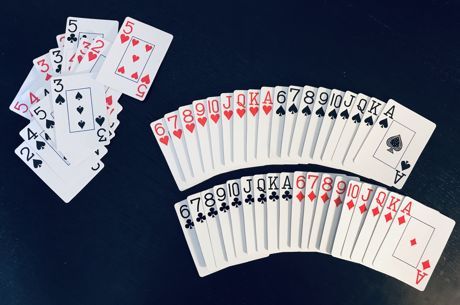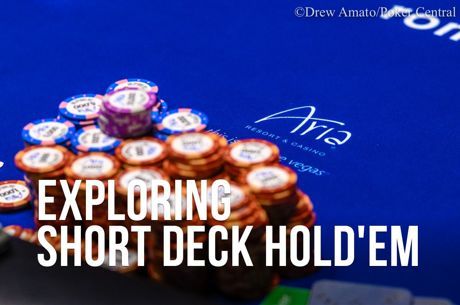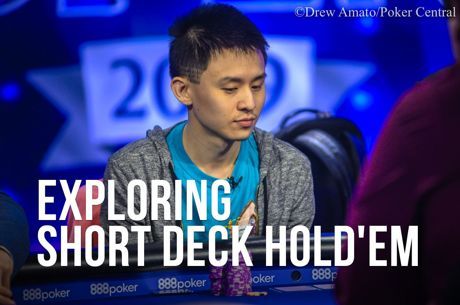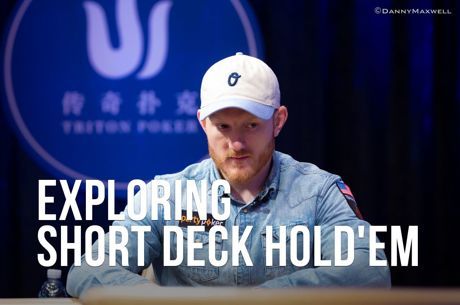Exploring Short Deck Hold'em, Part 2: Odds and Probabilities

Table Of Contents
In this series we are offering various strategy advice for short deck hold'em, also sometimes called six plus hold'em (or 6+ hold'em), including sharing tips from some of the pros who have found the game a fun and challenging poker variant to play.
Before we delve any further into strategy, with this article we're going to highlight some of the more interesting and notable odds and probabilities in short deck hold'em. In particular, we'll point out how those odds and probabilities differ from what you encounter in regular, full deck hold'em, which in turn creates some important differences when it comes to strategy.
Short Deck Hold'em (Six Plus Hold'em): Rules and Hand Rankings
As discussed last week, short deck hold'em tosses out all of the fives, fours, threes, and twos, creating a 36-card deck with which to play. The game is played just like regular hold'em, with players being dealt two hole cards and making hands with the five community cards dealt as a flop, turn, and river. Also, as in regular hold'em the ace can be high or low, meaning in short deck A-6-7-8-9 makes a straight.
The big change from regular hold'em comes from the hand rankings being altered. In short deck, flushes rank above full houses, and depending on the game it is sometimes the case that three of a kind beats straights.
| Regular hold'em | Short deck (straights beat trips) | Short deck (trips beat straights) |
|---|---|---|
| Royal Flush | Royal Flush | Royal Flush |
| Straight Flush | Straight Flush | Straight Flush |
| Four of a Kind | Four of a Kind | Four of a Kind |
| Full House | Flush | Flush |
| Flush | Full House | Full House |
| Straight | Straight | Three of a Kind |
| Three of a Kind | Three of a Kind | Straight |
| Two Pair | Two Pair | Two Pair |
| One Pair | One Pair | One Pair |
| High Card | High Card | High Card |
The reason for these changes has to do with the fact that in short deck the probabilities of making certain hands are different. In short deck, it is actually easier to make a full house than a flush, which is why flushes rank higher than full houses. (The opposite is true in regular hold'em.) It is also easier to make a straight than to make trips in short deck, which is why some rank three of a kind higher than a straight.
While some short deck games use small and big blinds just like in regular hold'em (with or without antes), others have introduced another twist by removing the blinds and having all players ante, with the button putting in a double-ante and play beginning before the flop with the player left of the button having an option to call, fold, or raise.
Short Deck Hold'em (Six Plus Hold'em): Preflop Probabilities
If you're a regular hold'em player, you're probably well acquainted with probabilities related to starting hands, and therefore know the chances of getting dealt pocket aces (1 in 221), a pocket pair (1 in 17), or two cards of the same suit (1 in 4.25). But what happens to those preflop probabilities after the fives through deuces are removed from the deck?
As you might imagine, reducing the deck from 52 cards down to 36 cards also reduces the number of different starting hand combinations there are.
Whereas in regular hold'em there are 1,326 distinct starting hands, in short deck hold'em there are only 630 distinct starting hands — less than half (about 47.5 percent). That's counting suits as distinct, which isn't generally done when valuing starting hand strength.
If we don't consider suits as distinct, in regular hold'em there are just 169 combinations of starting hands (13 pocket pairs, 78 non-paired suited hands, and 78 non-paired unsuited hands). Meanwhile when not considering suits as distinct, in short deck hold'em there are just 81 combinations of hands (9 pocket pairs, 36 non-paired suited hands, and 36 non-paired unsuited hands) — again, less than half as many in short deck versus regular hold'em (about 47.9 percent).
Fewer starting hand combos obviously affects the frequency with which you are dealt specific hands. For example, when it comes to being dealt pocket aces, that happens about twice as often in short deck hold'em — once every 105 hands (just under one percent of the time).
Pocket pairs come around more frequently in short deck, too — once every 11.66 hands (about 8.6 percent of the time). That's almost 1.5-times as often as in regular hold'em.
Meanwhile in short deck you're dealt suited hands at just about the same frequency as in regular hold'em — once every 4.375 hands (or about 22.8 percent of the time).
Here is all of that in table form, with a couple more comparisons of probabilities added to the list:
| Regular hold'em | Short deck (Six Plus) hold'em | |
|---|---|---|
| Number of cards used | 52 | 36 |
| Distinct starting hands | 1,326 | 630 |
| Distinct non-equivalent starting hands | 169 | 81 |
| Probability of being dealt pocket aces | 0.45% (1 in 221) | 0.95% (1 in 105) |
| Probability of being dealt any pocket pair | 5.9% (1 in 17) | 8.6% (1 in 11.66) |
| Probability of being dealt any suited hand | 23.5% (1 in 4.25) | 22.9% (1 in 4.4) |
| Probability of being dealt connectors | 15.7% (1 in 6.4) | 22.9% (1 in 4.4) |
| Probability of being dealt ace-king | 1.2% (1 in 83) | 2.5% (1 in 39) |
| Probability of being dealt two Broadway cards | 14.3% (1 in 7) | 30.2% (1 in 3.3) |
It’s obvious players have to adjust their thinking when it comes to starting hands and their value in short deck hold’em. Hand values go up in short deck, so what might seem like a decent starting hand in regular hold’em is going to be average or worse in short deck.
Another preflop issue to keep in mind — with fewer starting hands overall, that means the gap in equities between starting hands is narrower as well. For example, in a preflop all-in situation, A♣A♥ is about a 78 percent favorite to beat J♠10♠ in regular hold'em, but in short deck hold'em the aces are only about 63-67 percent to win depending on the rules being used. Search online for "short deck hold'em calculator" or "six plus hold'em calculator" if you're curious to test out some hand comparisons using some recently-built equity calculators.
We’ll talk more about preflop strategy in the next installment.
Short Deck Hold'em (Six Plus Hold'em): Postflop Odds
Postflop is where short deck hold'em introduces some surprises to new players, since the odds and probabilities can be quite different from regular hold'em.
Of course, if you just take a moment to think about it, it's obvious that when drawing to a certain number of outs, the chance of hitting your needed card changes when there are fewer cards left in the deck.
Let's say you hold J♠10♣ and the flop comes Q♦9♣6♥ to give you an open-ended straight draw. You have eight outs (the kings and the eights) to fill your straight, but instead of there being 47 unseen cards (as in regular hold'em), there are only 31 unseen cards in short deck. Whereas in regular hold'em you'd have an 8 in 47 chance of filling your straight on the turn (about 17 percent), in short deck hold'em your odds of turning the straight are 8 in 31 (nearly 26 percent).
I have seen discussions of short deck hold'em outs recommending players replace the "Rule of 2 and 4" from regular hold'em with a new "Rule of 3 and 6" for short deck. In regular hold'em, if you flop an open-ended straight draw with eight outs, you can roughly estimate your chance of filling the straight by multiplying those eight outs by two for the turn (~16 percent) and by four for the turn and river (~32 percent).
In short deck you can do something similar, multiplying your eight outs by three for the turn (~24 percent, which is close to the actual 25.8 percent) and by six for the turn and river (~48 percent, which is also close to the actual 45.6 percent).
Here's a table showing how your odds of hitting a certain number of outs change from regular hold'em to short deck:
| Regular Hold’em Outs | Turn | Turn+River | Short Deck Hold’em Outs | Turn | Turn+River | |
|---|---|---|---|---|---|---|
| 1 | 2.1% | 4.3% | 1 | 3.2% | 6.5% | |
| 2 | 4.3% | 8.4% | 2 | 6.5% | 12.7% | |
| 3 | 6.4% | 12.5% | 3 | 9.7% | 18.7% | |
| 4 | 8.5% | 16.5% | 4 | 12.9% | 24.5% | |
| 5 | 10.6% | 20.4% | 5 | 16.1% | 30.1% | |
| 6 | 12.8% | 24.1% | 6 | 19.4% | 35.5% | |
| 7 | 14.9% | 27.8% | 7 | 22.6% | 40.6% | |
| 8 | 17.0% | 31.5% | 8 | 25.8% | 45.6% | |
| 9 | 19.1% | 35.0% | 9 | 29.0% | 50.3% | |
| 12 | 25.5% | 38.4% | 12 | 38.7% | 63.2% | |
| 15 | 31.9% | 54.1% | 15 | 48.4% | 74.2% |
By the way, don’t forget when you are drawing to a flush that there are fewer outs available to you in short deck than in regular hold'em. If you flop a flush draw in regular hold’em you have nine outs, but in short deck you only have five.
Short Deck Poker Strategy
As already noted, hand values tend to be higher in short deck hold’em, which means one-pair hands aren’t going to be as strong postflop in short deck as they are in regular hold’em. And thanks to the increased chance of players filling draws, those one-pair hands and other modest “made hands” are going to be more vulnerable, too.
Speaking of pairs, it's important to remember that pocket pairs in short deck should be valued drastically differently. Aces and kings are obviously strong hands in regular hold'em, and that stays true in short deck, except the difference between the two is even more pronounced.
Things change quickly after that as pairs below kings are unexciting holdings in short deck. The reason for this will be familiar to any pot-limit Omaha player of decent experience level: similar to PLO, the only easily dominated hands in short deck are pocket pairs.
Where traditional "dominated" spots in hold'em — like ace-queen against queens — are much closer in equity in short deck, holding a pair versus a higher pair is still a pretty rough spot. And medium pairs are actually a slight dog against overcards, in contrast to regular hold'em. Pairing hole cards happens much more often in short deck, and it's far easier for connecting cards to make straights.
Because equities run much closer in short deck, it's important to maximize opportunities for high-equity spots like holding bigger pairs while minimizing the times you're on the wrong side of that.
A few other items related to postflop probabilities in short deck:
- with suited cards you flop flush draws less often in short deck, and complete flushes less often as well
- with connectors and one-gappers you flop straight draws more often in short deck, and complete them more often, too
- with a pocket pair, you flop a set more often in short deck (about 17 percent of the time vs. 12 percent in regular hold’em
We'll be exploring postflop strategy in more detail going forward in the series as well. Blockers, bluffing opportunities and more will be examined in the coming weeks.
Meanwhile, take a look at the video below and listen to Tom Dwan, Patrik Antonius, Daniel Cates, Kane Kalas, Jason Koon, Phil Ivey, Wai Kin Yong, and Gabe Patgorski offer some general advice about how to approach short deck hold’em strategy.











